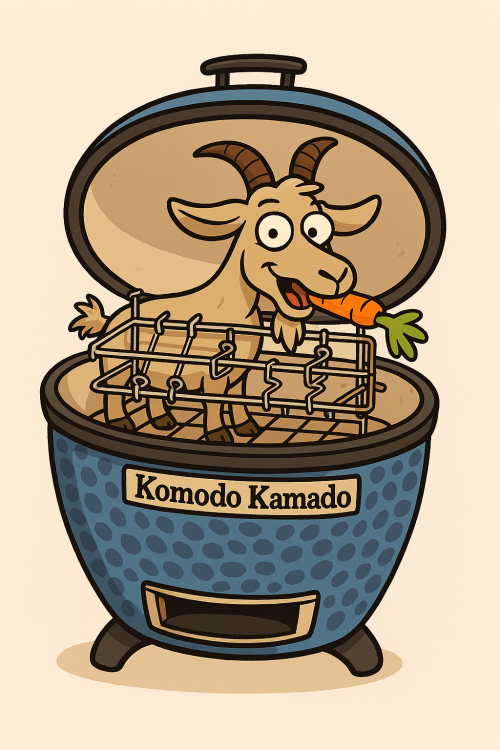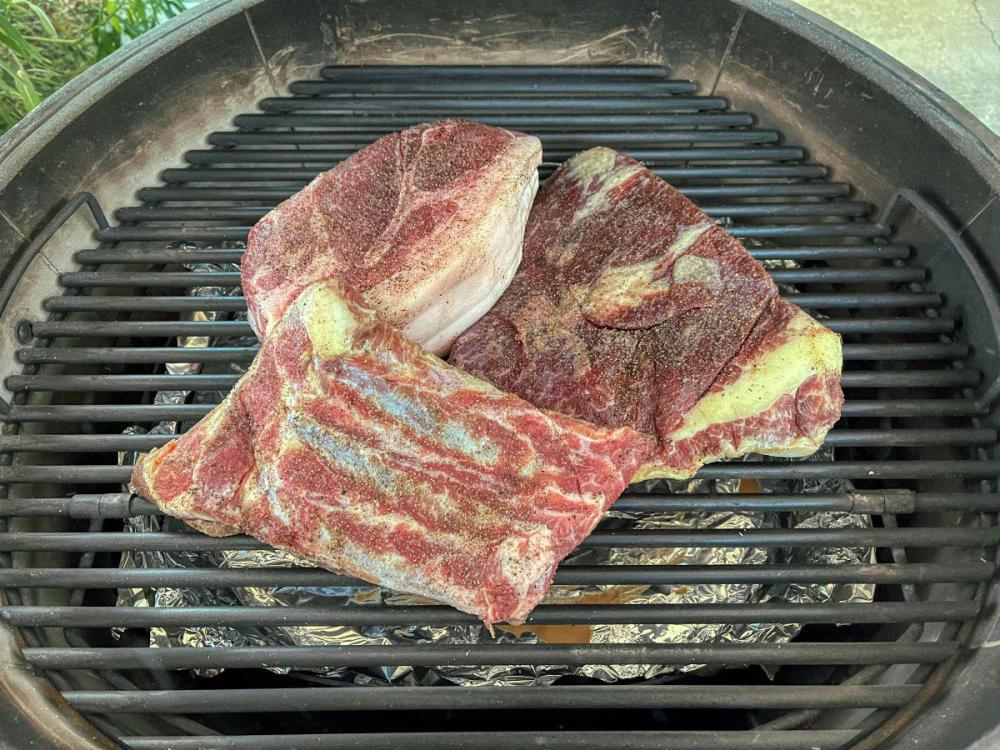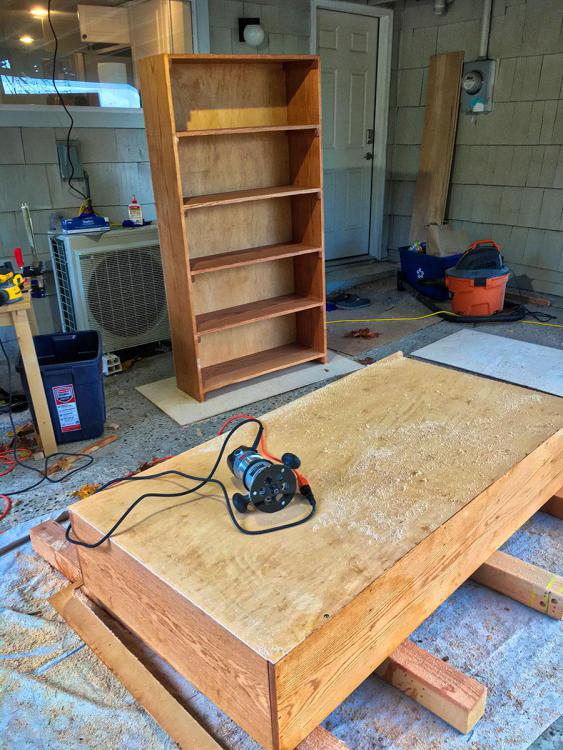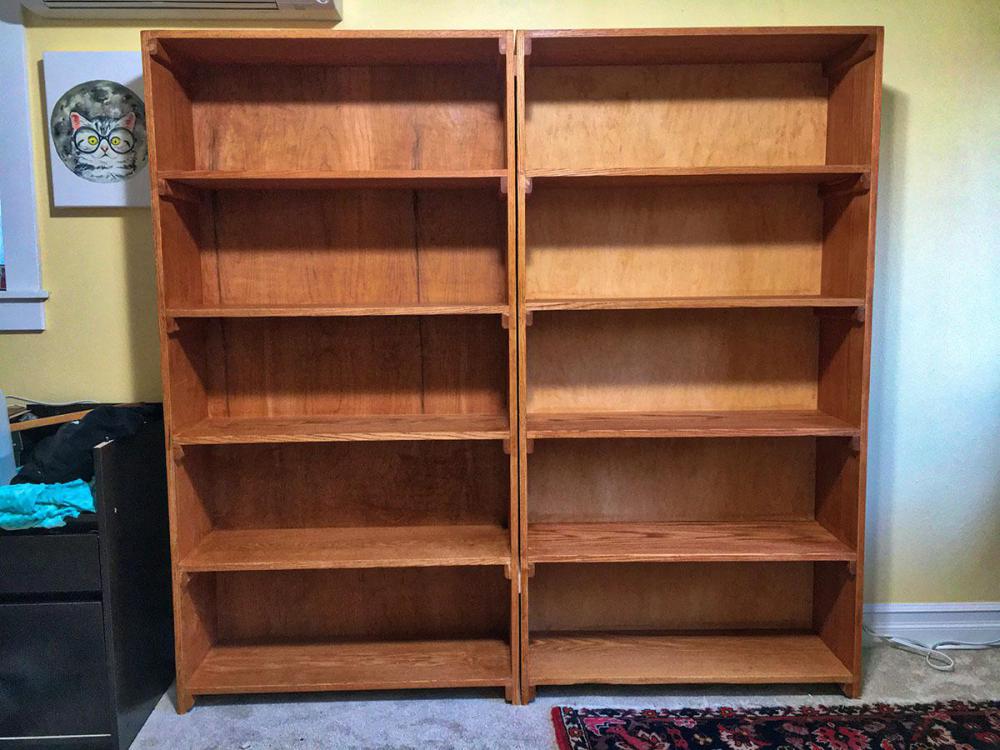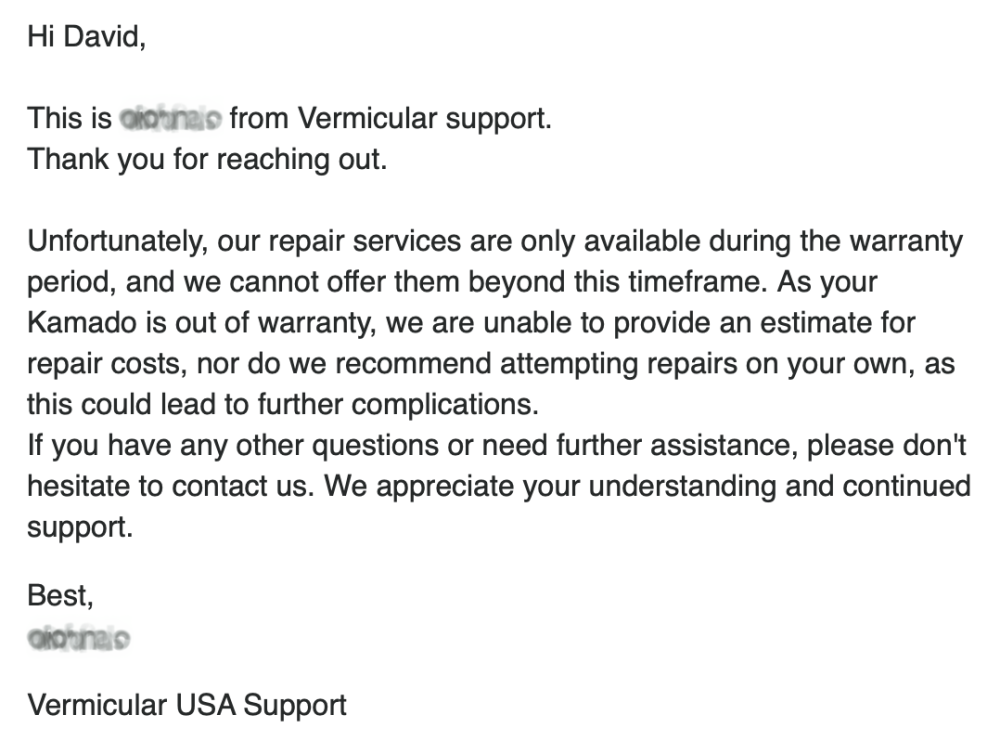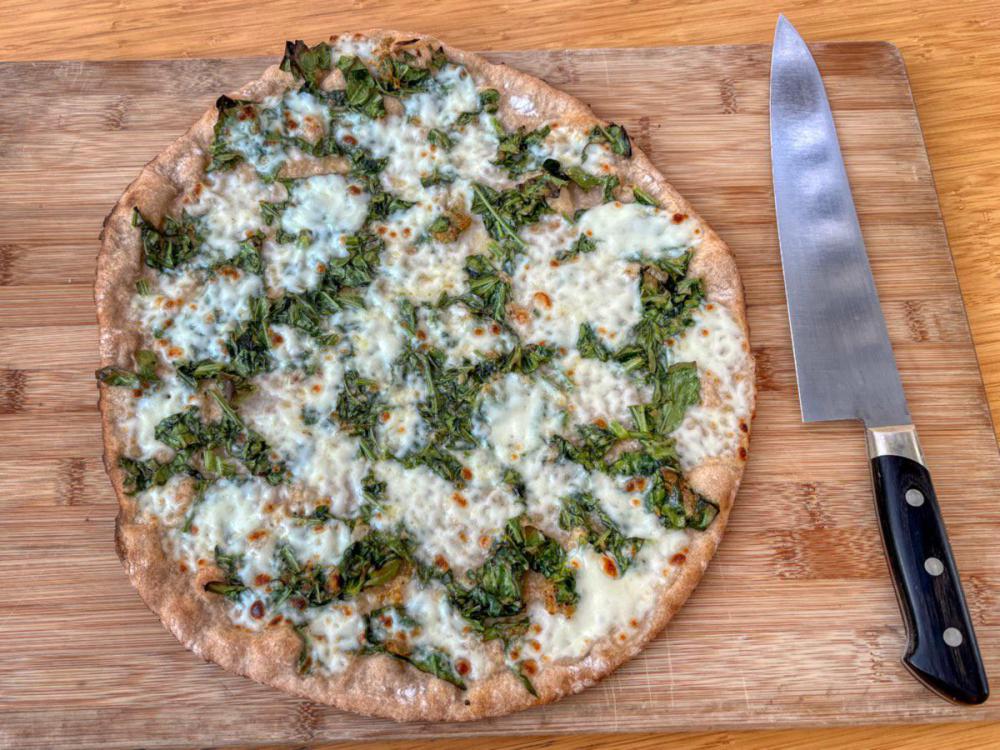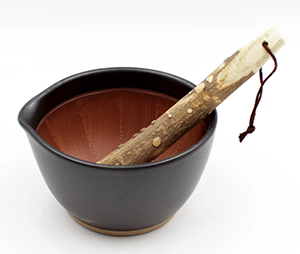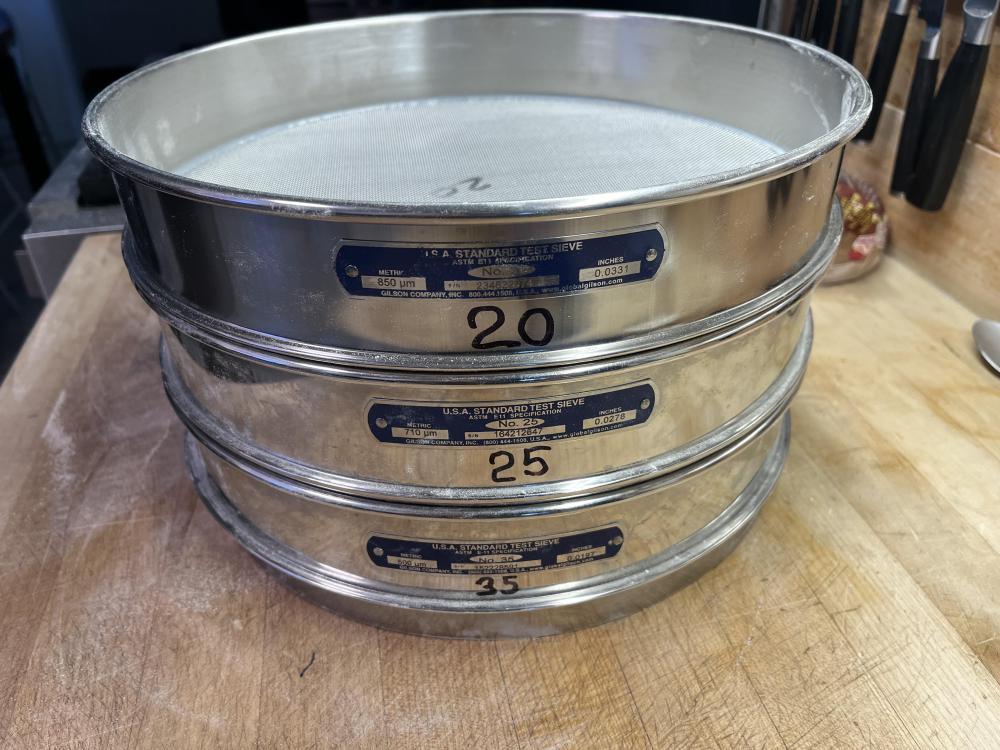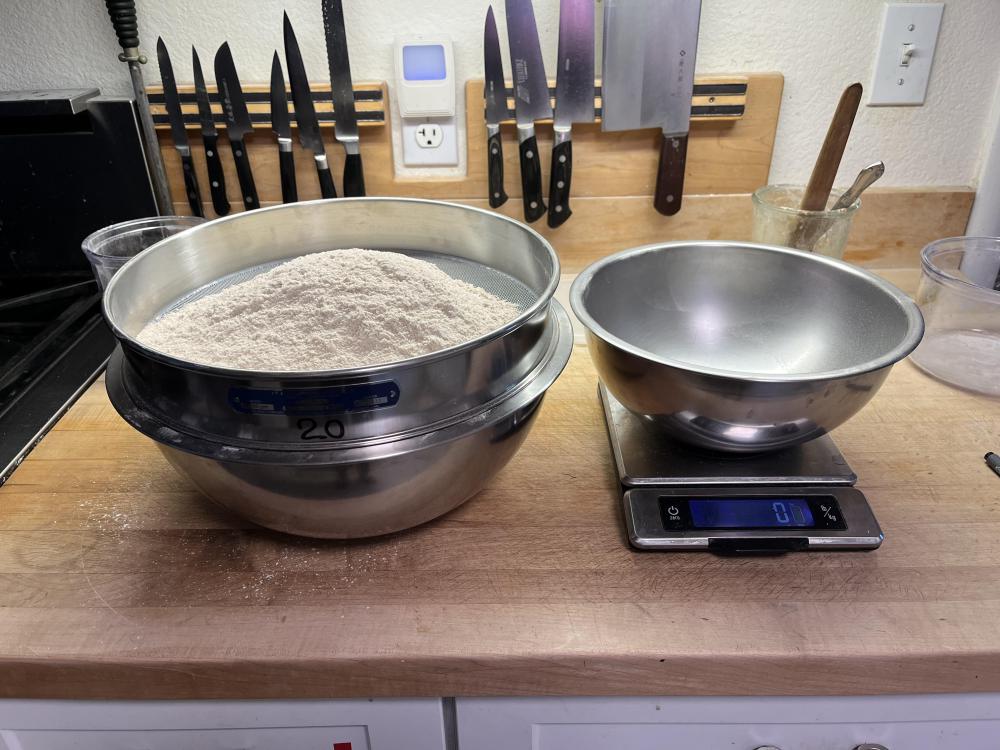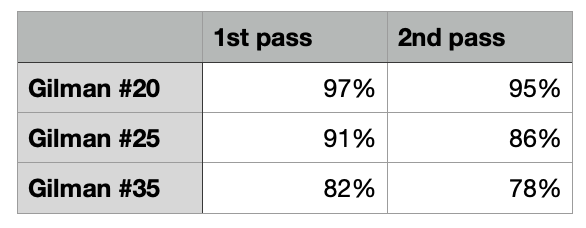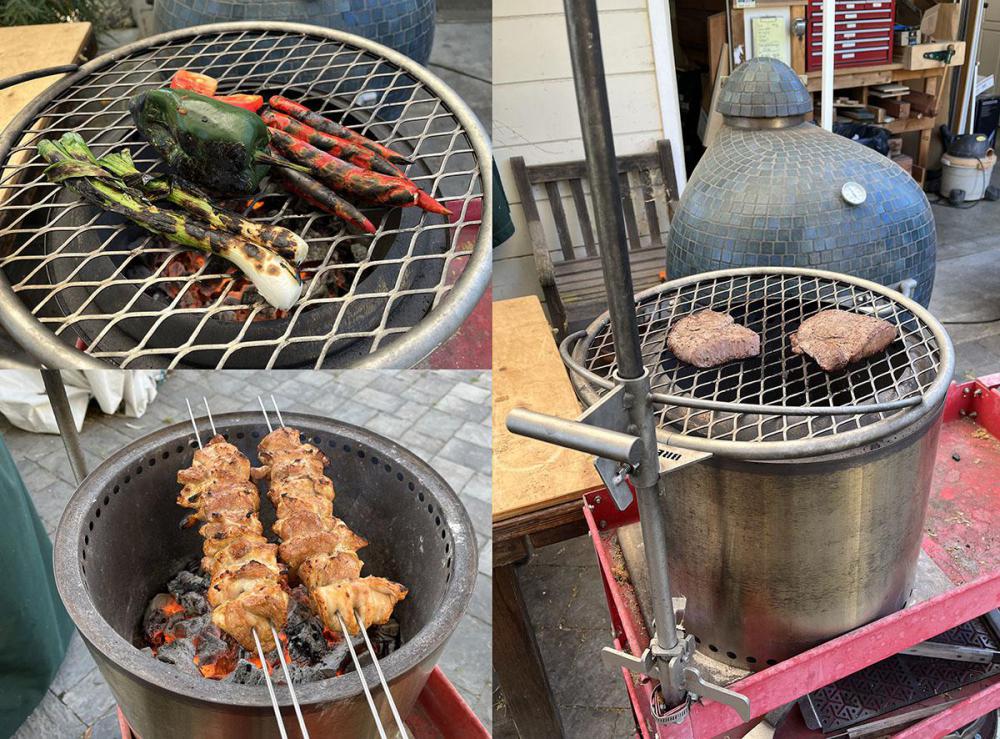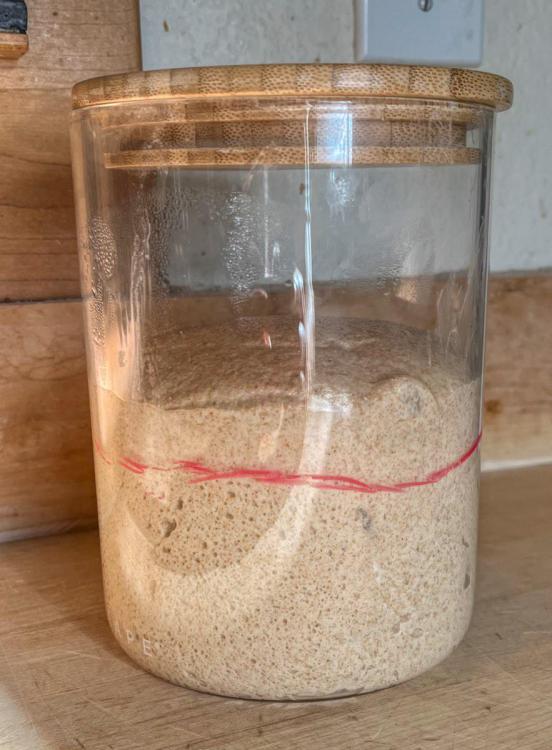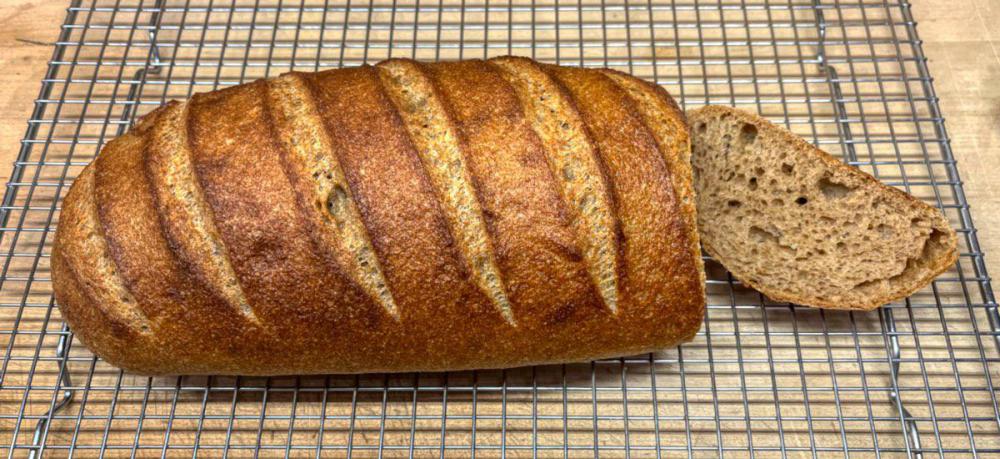-
Posts
1,725 -
Joined
-
Last visited
-
Days Won
50
Content Type
Profiles
Forums
Events
Everything posted by Syzygies
-
Apollo 12 needed to land within walking distance of the Surveyor 3 robotic probe. The moon's lumpy gravity proved a challenge for Apollo 11's landing, so NASA introduced a feedback loop, and nearly landed on top of the Surveyor. The poster child for this cooking debate would be salt. Many people are fiercely proud of portioning salt by eye. Cooking is part theatre, and making a show of pinching salt as a restaurant chef would do is good theatre. We can taste the difference for each 0.1% step of salt by meat or fish weight, and we've never met anyone who can eye salt to this accuracy, so we measure. We like to land within walking distance. A KK with no controller is astonishingly stable, but needs periodic adjustments. Fixed settings determine the geometry of the airflow, and oxygen determines heat production, but this isn't what an engineer calls a stable equilibrium. Open the lid to tend to the meat, and with greater airflow the fire gets hotter. Hotter air generates a greater pressure differential through the fixed geometry of the airflow, which increases the airflow, which sustains a hotter fire. Even if one never opens the lid, nighttime changes in outdoor temperature, and variations in the evolution of the fire, can similarly change the airflow for a fixed opening geometry. This is a mild effect, but every 15 degrees affects the cook. One either embraces these variations as the romance of barbecue, or periodically steers.
-
I'm almost there, but I like to sleep through overnight cooks. One can nail 225 F manually "most of the time" and sleep through the night, but "most of the time" doesn't cut it when 50 people are depending on the result, or the brisket cost $120. I like to measure my pit temp by sticking my probe through the TelTru dome thermometer hole. This is contrary to most advice, but it doesn't matter as long as one is consistent and understands one's cooks. The dome runs hotter till the KK stabilizes, so this yields a more gentle approach to cruising altitude. And I can set 450 F for bread without heat damage to the probe wire. So yes, my lesson has been to not overreach, just use a feedback loop without embarrassment to set my pit temp.
-
I really wish I'd never bought my UltraQ. I've been a BBQ Guru fan since they were the best option, which was apparently long ago. That mechanical dial thingy, then two DigiQs, and now (for some reason, the DigiQs both work) the UltraQ. I love how I can mount the UltraQ on my garage wall, and see the pit temp from far away. One would think I bought the UltraQ so my phone would tell me the pit temp from far away? Even after deleting ShareMyCook and standing right next to the UtraQ, the phone will show stale data while lying about the update time. This is inexcusably stupid. It's not rocket science to handle messages so that one never falsely depends on stale data. I want a warning if my actual data is more than a minute old, not a lie. I should only see that warning when I'm out of bluetooth range. For those of us good at programming computers, it comes as a surprise how well or badly such apps work. My ceiling fan app is unpredictable, from an upscale company. I always thought of Leviton as generic box store stuff, but their smart switches are bomb-proof. One can stand in the garage and manually flip a switch while my wife watches the Leviton phone app in the house, and the new state shows instantly. From this perspective, whomever BBQ Guru hired are the dumb kids in the class. My various AI consoles tell me people think more highly of FireBoard products. The kicker for me was intermittent connectivity for my meat probe, in any UltraQ meat port. AI tells me this could be the probe (out of warranty) or the UltraQ (still under warranty). I just don't have time for this, I'd rather pay top dollar for something that just works. Wireless probes? Huh. For now, given that I'm this close to offering my UltraQ here for $25, I decided that for $25 I'd buy it as a pit temp monitor and fan controller with a nice display. So I'm keeping it, but one further failure and I trash it, move on.
-
Long time 23" Ultimate owner. I've experimented with many approaches to "radiant heat". I wouldn't double the basket splitter. I'm a big fan of the 23" ULTIMATE DOUBLE BOTTOM DRIP PAN. It makes a great heat deflector, and an easy to clean drip pan when lined with foil. (Some people use the drippings for gravy, where the double bottom helps prevent scorching.) I use it as a heat deflector for pizza. Using any ceramic cooker as a pizza oven, one needs to confront the "heat from the bottom" effect. Wood-fired dome pizza ovens don't work this way. The best deflector helps here. Long ago, I'd get several years at a time out of a giant unglazed plant saucer (no lead risk) lined with foil. Again, leave several inches around the outside. The real art to radiant heat is to time the fire's arc. Cook on the return from "low earth orbit" when the fire is waning but the dome remembers.
-
Custom manufacturing has turned being a DIY "maker" on its head. I've personally used SendCutSend, Ponoko, Western Dovetail. My master woodworker neighbor hasn't made a drawer for clients in years; why do! My Venetian Bigolaro came with a handle that couldn't take the stresses of more restrictive pasta dies, so I made my own handle. Same for stainless steel spacers for my Orange-X juicer, or to better seal the interface between our kitchen faucet and sink... My 23" basket splitter is just a couple pieces of flat metal that fit together same logic as some cardboard boxes. I could upload a picture. Me, I'd mock one up in plywood, just don't light it. Be aware that most metals don't belong in a food cooker, so don't improvise: Galvanized metal in particular offgases toxins. There are always metal working shops in town, too. Get a quote. They could be half the price of buying a pizza steel from Baking Steel, at the expense of hours of prep. They were twice the price for my bigolaro handle. Our KK community is experimental, and Dennis has perfected various community good ideas once they get traction.
-

adjustment to my standard 2/1/1 babyback recipe....
Syzygies replied to BARDSLJR's topic in KK Cooking
One can butcher or request "country-style ribs". They are indeed cut from the blade end of the pork loin, near the shoulder, often with generous meat. I used to cut these myself, trial and error after buying bone-in pork loin roasts. I'd always put the bones back in, and eventually it dawned on me... -

I'm looking for a photo of a lamb/goat in a roti cradle.
Syzygies replied to DennisLinkletter's topic in Komodo General
-
A few decades ago I was at a math conference in College Station, Texas, and lead various forays into the town's ok BBQ. On yet another wine buying stop for the courtyard parties at our hotel, I asked if I'd found the best place. I don't It's tough being a New Yorker, while traveling. Paragraphs flit by in one's mind in the pauses between words, elsewhere. It's polite to appear to be paying attention, but that requires focus. eat barbecue Oh gawd! I'm asking the one vegetarian outside Austin! How do I get out of this conversation gracefully? round here! Well then! He sent me to Elgin, Texas. They're known for their hot links, sold in supermarkets across the state, but there were several places selling extraordinary brisket. My own best efforts would be #2, #3, #4 for me, but they were #1. I brought back more on the plane to NYC (causing some commotion) to reheat at the kind of wine tasting I now avoid. They started ordering delivery.
-
How low does your (convection?) oven go? We can all imagine the obvious worst case scenario here, but if you don't bump the knob your house shouldn't burn down. The obvious choice (safer but more work): your KK is an oven. As it cools after a regular cook, use it to dry pellets? I have a KK double bottom drip pan which I use all the time as a heat deflector; on the main rack filled with pellets, once the KK cooled far enough, would be a great drying environment.
-
Huh. I don't doubt your experience, but it's quite different from mine. I'd love to meet you halfway. What KK? What stone? What dome temperature? How long do you let the fire settle, stone heat? I do have a baking steel, but it's dedicated to tortillas; I don't want to mess with its seasoning.
-
I'm a fan of the gas burner assembly. I get the impression that there aren't many of us, but it has its uses. As a general principle, one can take the approach of learning how to use a KK with minimal accessories, and then buying later to meet recognized needs. How one imagines the KK will work rarely corresponds to how one observes that it actually works. It's hard to identify needs in advance, before getting experience. That said, I consider the pizza stone, and the double bottom drip pan, essential equipment. I use the gas burner assembly to get a hot fire going more quickly, for example for pizza. The issue is that one is lighting charcoal from underneath, so the fire wants to burn all at once then go out. This can be mitigated by controlling airflow, and by using large pieces of lump, such as one can buy from Fogo. As Dennis notes, one could turn off the gas but leave the gas burner inserted. I swap it for the regular door. It just feels right to get propane equipment out of the way, though I recognize that there's no actual safety issue here. My approach to pizza is to catch the KK on a downward arc, where the fire is mostly spent but the walls are still radiating a good deal of heat. I don't let the fire go into low earth orbit, because the pizza stone will get too hot, so I control airflow to limit the maximum temperature. On the other hand, the pizza stone needs to get hot enough; this is a balancing act. This is where I consider the double bottom drip pan to be essential; it's the best heat deflector for shielding the pizza stone from the fire below. In a conventional wood-fired pizza oven, the fire is not below. Using a KK, this is a key difference that requires attention. One doesn't want a burnt crust before the top is done. With this approach, I don't care that the fire has been lit from below and wants to burn all at once. My goal is to burn it all at once, within my imposed upper temperature limit.
-
We don't eat hunks of meat as often as we used to; our KK sees most use for chicken, pizza, Focaccia di Recco, bread. I do quick grilling (salsa veggies, taco meat) over a Solo Stove fire pit, the air fryer of the gods. We nevertheless use lots of meat-as-ingredient, and what meat isn't better with smoke? Then there's the Maillard reaction, very special in a KK. Thinning the herd in the chest freezer... The pork butt will become carnitas or tamales filling, the ribs will become a pasta sauce from Rosetta Costantino's My Calabria (we just got back from her food tour), and the brisket will become braised beef for Dan Dan noodles from Robert Delf's The Good Food of Szechuan.
-
Beautiful! Back in the shallow end of the swimming pool, I'm also fond of guerrilla woodworking. At our daughter's previous house in Salem, Oregon, working outside in her carport next to pouring rain with minimal tools, watching the wood warp in real time as I worked. I rejected dado cut joints in favor of explicit shelf supports I could clamp the shelves onto, taking out cupping as I screwed them in. Back went on last. Serviceable, and they made the move to her new house in Arizona.
-

Vermicular Cast Iron Induction Cooker
Syzygies replied to PVPAUL's topic in Relevant Product Reviews
We love our Vermicular Musui Kamado, and use it frequently. Also, as part of the cohort that can afford a Komodo Kamado, we did not blink at buying a new Vermicular Kamado (base) after our original touch display failed after four years. They may be Japanese, but they're not Toyota. Anyone who is on the fence over price needs to accept that the $340 (USD) Kamado base is potentially a purchase every three years. If someone's reaction is "screw them!" I understand. While I can be dispassionate enough to repurchase the base, I'm also fairly pissed off that they didn't at least volunteer a technical description of what is typically wrong, and what they'd do under warranty. Although, my own experience is that they replace rather than repair. While I appreciated the new unit, this is how we're destroying the planet. -
I asked my wife, who belongs to a Greek Orthodox church. Her immediate answer: They overcook it. My advice would be heretical: Sous vide for a long time at a rather rare target temperature, then grill on the KK to get a nice exterior. That's my go-to for any meat better served rare than "low and slow" trad BBQ.
- 1 reply
-
- 1
-

-
At the moment the two most recent threads are spam, 5 and 10 hours old, by different posters. There are dozens of people here I would trust with the authority to delete threads, under a "one strike" rule: If any deletion is even remotely a judgment call, as determined by our actual admins, that authority is permanently revoked. None of these spam threads would last 30 minutes, under such a system. I'm going to take a break from posting until we sort this out.
-
May I ask, what is the rack? I want one!
-
I ordered the Fourneau mat, which fits on my mini pizza peel, and doesn't need handles. I do own scissors, but do the BreadMat-C handles get in the way of closing the Challenger? Once I toss in three ice cubes, I feel like I'm on a tight clock. Steam does make its way between the Challenger pieces and the knitting of the Challenger gloves. I've never been burned, but I don't feel like waiting around! As in, any extra step that takes another half second would be dumb. They do say two ice cubes, but they don't specify a size. Huh. Their handles are to overcome the difficulties in lowering an unbaked loaf into a tall-sided Dutch oven. A solid border prevents deforming the loaf. However, the Challenger doesn't have tall sides, and readily accepts my mini pizza peel. Do the handles stay up, so they're never in the way when one replaces the Challenger lid?
-
FOURNEAU 2.0 SILICONE BAKING MAT Yes, that mat is approximately 11.25" x 6.75", and the Challenger interior dimensions are 11.5" x 9". So that would work!
-
Katakuchi Suribachi & Surikogi Set Last night's KK cook was a pair of white arrugula pizzas. Arrugula from our garden, that wasn't going to wait. We like a crisp, almost cracker crust from whole grain, as one approach to pizza. Last night I made a small change to my technique, that I quite liked: Dress the arrugula with the olive oil topping, and spread onto a dry pizza. This was easier than tugging oil across the crust itself (yes, not that challenging, but this was noticeably easier). It seems the crust had more chance to breathe as it baked. I briefly microwaved a few cloves of garlic, and mashed this in my favorite suribachi (I have all three sizes but I regularly gift the middle one as most used) with olive oil, preserved lemon, black pepper and maras pepper. If one leaves out preserved lemon, add salt.
-
Stainless Steel Pizza Peel With Collapsible Rosewood Handle Relays could work, but they call it The Challenger for a reason! Their suggested directions are to preheat at 500 F, put in the loaf with a few ice cubes, reduce the heat to 425 F and bake 20 minutes covered, then 12 minutes uncovered. I flip the lid and put the base on the lid. I find that these directions work well for a range of breads. Sometimes I rotate halfway through the 12 minutes uncovered. Sometimes I go 15 minutes. Sometimes I flip the loaf bottom side up for the last few minutes. I've been working with 80% hydration, 95% extraction doughs from freshly ground grain. This poses challenges; I generally bake cold from an extended fridge ferment. My loaves would stick without parchment paper underneath; I use the above mini pizza peel to move them without damage. I've tried removing the parchment paper at the 20 minute uncovering mark, and the loaves still aren't completely set. I now just let the parchment paper ride, perhaps up to the final flip. In practice, one can't adjust KK temperatures this rapidly, and one often doesn't want to run an indoor oven longer than necessary. I find that once The Challenger itself reads 425 F using an infrared shooter, we're good to go. With the KK, I'll arc high and ease down to target temperature. So you could run a relay pipeline, if you have a stone or steel that fits next to The Challenger, while maintaining a constant baking temperature.
-
I now have three Gilson test sieves, purchased over the last decade. The #20 arrived yesterday, so I made some careful extraction estimates. We have an older Wolfgang Mock Grain Mill, that most closely resembles (and takes the same replacement stones as) the KoMo Fidibus 21. A comprehensive US source is Grain Mill, Flour Mill, Grinder | Stone Burr, Impact & Steel Burr Mills at Pleasant Hill Grain. They also recommend the Royal Lee Household Mill if one's exclusive goal is the finest possible flour. I would contact them for buying advice; the newer Mockmill 100 & 200 probably represent the best value and performance, if one is not put off by their appearance. I adjusted my mill to grind as finely as possible without gnashing stones, then tested one and two passes of 500g hard red winter wheat from Central Milling, with each of my sieves. The extraction percentages are shown in the above chart. One can buy Gilson sieves from sources such as Amazon, or directly from Gilson. It's worth consulting Gilson first, to understand options. ASTM Test Sieves | USA Standard Test Sieve - Gilson Co. What is a Sieve? Make Sure You Choose the Right One - Gilson Co. 12" Sieve, All Stainless, Intermediate Height, No.20 - Gilson Co. 12" Sieve, All Stainless, Intermediate Height, No.25 - Gilson Co. 12" Sieve, All Stainless, Intermediate Height, No.35 - Gilson Co. These sieves are expensive but remarkably well-made. They fit perfectly into a Vollrath 69080 8-quart heavy-duty stainless steel mixing bowl, universally available from restaurant supply stores and Amazon. These bowls are the best quality I know; we have multiples of many sizes. I have a friend who cheaps out whenever he thinks it doesn't matter to free up an extra $40 for one night's wine, and his wife is still gnashing her teeth that he didn't get Vollrath bowls. The quality difference is striking.
-

I think the branding is all wrong on these...
Syzygies replied to Mr. Natural's topic in Forum Members
As my off-brand POSK disintegrated, my wife bought me our 23KK. I didn't put up much of a fight. She was tickled to talk with Dennis; people should consider putting uncertain spouses on the phone with him. I wish I had his charm. I wouldn't go bigger, doing it over again myself. I've fed 80 people out of my 23KK. Two zones? My KK is my oven, used most often for bread, pizza, Focaccia di Recco, roast or tandoor chicken, and monumental smoked meats. My Solo Stove Ranger is my grill. Sometimes I'll be smoking pork for carnitas in the 23KK, at the same time that I'm grilling vegetables for salsa on the Solo Stove. I have a Weber kettle we haven't touched in years. Kettles are a fundamental design, brilliant for their day, but one can now do much better. I now associated kettles with the taste of burned chicken fat, guests in someone else's yard. Worst case they make me do the grilling on a mismanaged fire, like a pitcher left out to take one for the team. I can set a fire in my Solo Stove in a couple of minutes: wood chunks, lump charcoal partway up, a splash of 99% isopropyl alcohol, throw in a match, then come back in 30 or 40 minutes to a perfect fire. The vertical, smokeless column of hot air combines all the hype of air fryers with traditional grilling over fire. I get much more uniform cooks than I've even seen anyone get with close-to-the-fire grilling, and better flavor. Mine is a Frankenstein rig (a Breeo Outpost adjustable grill grafted onto a Harbor Freight service cart) but Solo Stove has caught on to cooking on their fire pits, and offers some interesting options if one spelunks their site. They recommend wood as a fuel, concerned that a full load of charcoal could get too hot, but one never needs a full load. I layer wood then charcoal, as wood lights faster but charcoal lasts longer. There's a long KK Solo Stove thread. It starts out slow as we experiment, but has more information. -

Brød & Taylor Sourdough Home
Syzygies replied to Syzygies's topic in Bread, Pizza, Pastries or Desserts
Wow. I had thought of pitching all the bran into the levain to digest, as a way to stay 100% extraction, but I hadn't tried it yet. Bran slices gluten, and you're moderating this. Yes there are many factors influencing starter flavor. Temperature, hydration, timing, how much to carry over. Desem is a famous corner of this design space. I’ve been favoring lively starter at the expense of other characteristics, but I’ll get more confident. By expanding the behaviors we can offer, the real purpose of the Sourdough Home is to engage us in a relationship with our starter. As one wonders after tasting bread how baking technique and the recipe might influence its flavor, one wonders after smelling starter how handling technique and the recipe might influence its aroma. These involvements are twin aspects of naturally leavened bread making, on an equal footing. I sometimes think that these involvements are a scientific process for reaching an objective result. I sometimes think that these involvements themselves are instead the whole point, and imprint on the result exactly like other art forms. Paintings can reify thought, transferring part of the painter's inner world to a degree that can shake one's soul. Science can't explain this transference. People talk of a "passionate" cook? When one travels, why is eating the food so important to understanding the culture? When food is magical, it achieves this same kind of transference. -

Brød & Taylor Sourdough Home
Syzygies replied to Syzygies's topic in Bread, Pizza, Pastries or Desserts
I've logged 221 loaves of bread since 2011. After a long initial struggle trying to understand why freshly ground "green" flour didn't work, I settled on a sourdough recipe that was roughly half freshly ground hard red and rye flours, and half bread flour. I used some yeast to boost the sourdough, and worked through at room temperature on the bread's schedule, overruling mine. Every time I tried to work out a new recipe with these basic assumptions, I ended up back with the same recipe. This is true of so many things: Considering how hard I've worked at this, you'd think I'd be better. One's first reaction to the Sourdough Home could be that it's a convenience for feeding starter less often, without inducing a fridge coma. A more nuanced read is that fermenting bread can be every bit as subtle as fermenting wine, and the Sourdough Home is a tool that increases one's options. Mine provoked me to relearn bread with new ground rules: all freshly ground flour, nearly full extraction naturally leavened with no yeast cool phases to extend the fermentation time and allow more flexible scheduling My original inspiration was Desem bread, but I've evolved into a new equilibrium recipe. Above is my eighth try, and I'm starting to get the hang of it. We love the taste. My loaves are far from Instagram-craggy, and far from anything we can buy in the SF Bay area. My new several day protocol is this: prepare a levain from flour, water, starter hydrolyze the remaining flour with a few conditioners I expose the second mixture to a minute in a chamber vacuum machine, which accelerates the hydrolyzing process exactly as others use vacuums to marinate meats. Let both mixtures rest till the levain is ready. It's convenient preparing both mixtures at once, and the long hydrolyze gives the conditioners time to act. Combine these mixtures with a salt water solution Stretch and fold in a bowl, frequently for the first few hours Transfer to the Airscape glass canister, mark the level with a grease pencil, and place in 50 F Sourdough Home Wait another interval, typically overnight Pull out the dough, let return to room temperature and rise 20% above grease pencil line, typically 3-4 hours Bench rest, shape, place loaf in proofing basket or box Wait 2 1/2 hours, frustrated that the usual signals for overproofing don't seem to apply. Move the loaf to the fridge. Wait another interval, then get either the KK or an indoor range up to temperature. Bake cold from the fridge, typically in a Challenger Bread Pan. Baking cold from the fridge is a convenience that supports more flexible fire management, and it stiffens the dough so it won't sploof out so much. The additive I've settled upon are 2% vital wheat gluten 0.5% diastatic malt 60 ppm ascorbic acid For me these make a dramatic difference. Everyone's results vary. If you buy flour, even freshly milled full extraction, different ballgame. This is not Desem, but it's healthy.


